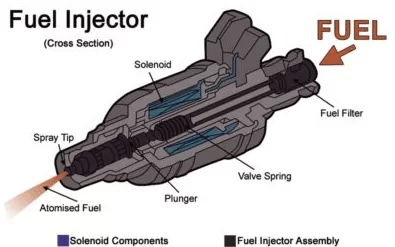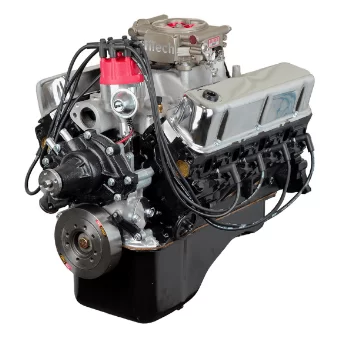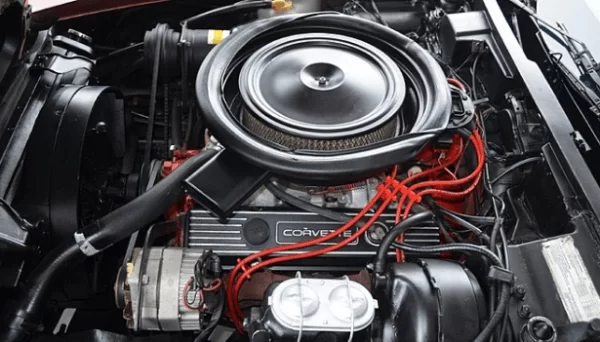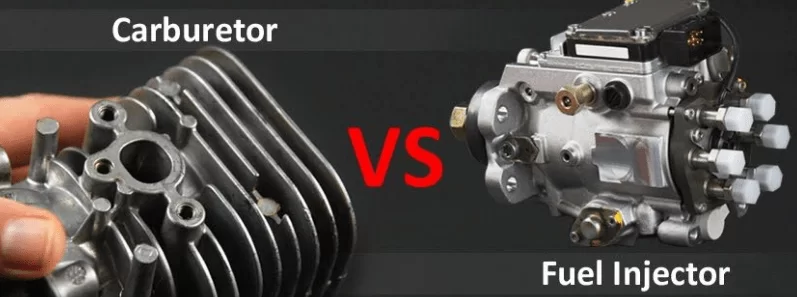As the world is shifting toward all electric cars but in some countries old engines like Carburetor and Efi are still in use. These engines have lost their importance in well developed countries but in countries like Pakistan and India these are still in demand and about 60-70 percent of vehicles on roads are still having these engines. As the sale-purchase of old cars is one of the top business in these countries that is why it is important to know some of the major differences among these engines.
EFI is now the primary fuel delivery system that used in automobile engines that replaced carburetors during 1980’s and 1990’s.
 EFI (Electronic fuel injection) is a system that injects the fuel into the internal combustion engine. The major difference between carburetors and fuel injection is that the fuel injection system atomizes the fuel from a little nozzle with high pressure while on the other hand; a carburetor works using a suction created by intake air accelerated through a venture tube to draw a fuel into the air stream.
EFI (Electronic fuel injection) is a system that injects the fuel into the internal combustion engine. The major difference between carburetors and fuel injection is that the fuel injection system atomizes the fuel from a little nozzle with high pressure while on the other hand; a carburetor works using a suction created by intake air accelerated through a venture tube to draw a fuel into the air stream.
A carburetor is a device that intermix the air and fuel for an internal combustion engine, air enters through a throttle valve which creates low pressure inside the venture tube and then it sucks-in the fuel from a jet.
There are some problems with the carburetor; it cannot give same air-fuel mixture to each cylinder because of the distance, some cylinders far away from the carburetor receives less air-fuel mixture with respect to closer ones. The twist band turns in the manifold that makes the fuel and air mixture to separate, this flow of it towards the cylinder makes it more difficult to give better fuel economy, performance and emissions because of the loss of the fuel with outgoing air. This results in incomplete combustion of fuel that further results in toxic emissions like CO (Carbon monoxide), NOx and HC.
Read Also: 2JZGTE- Car Enthusiasts Favorite Engine of all Times | Heart of Toyota Supra
To remove all of these problems Electronic Fuel Injection system combines sophisticated computer controls with a high pressure fuel delivery system to provide optimum power and fuel efficiency. It is controlled through an Electronic Control Unit (ECU).

There are three types of Electronic Fuel Injection System in the market today.
- Throttle body fuel injection
- Multipoint fuel injection
- Direct fuel injection.
Throttle body injection consists of an electrically controlled fuel injector placed above the throttle valve that sprays fuel into the throttle body. Fuel pressure is created by an electronic fuel pump and pressure is controlled by a regulator. Fuel entered inside the engine when the engine- computer energizes the injectors, this all occurs in a rapid series of short bursts rather than a continuous stream; it provides better atomization and does not have a troublesome choke mechanism.
Multipoint fuel injection system have a separate fuel injector for each cylinder. It provides further precision by varying the fuel quantity and injection timing by governing each injector separately. It is thereby improves the performance by controlling the emissions. Since only the air flows through the intake manifold and the intake manifold remains dry that is why there are no problems with fuel pudding when the engine is cold and fuel separation which cause fuel mixtures in the center and end cylinders.
Direct fuel injector system is a separate injector which is used for each cylinder but the injectors are relocated on the engine for spraying fuel directly into the combustion chamber other than the intake port. It uses the injector to spray the fuel at a very high pressure (2200) directly into the chamber of combustion.The mixing of air and fuel inside the combustion chamber rather than in the inlet manifold. Less amount of fuel is required to produce equivalent horsepower, the improvement of fuel economy and power from 12% to 25%.
Read Also: World’s Greatest Muscle Car- Dodge Demon With Jaw Dropping Power
Carburetors stay longer than fuel injection systems that favors the motor sports while EFI is much expensive than the carburetor. They both feed fuel and mixture inside the engine; these are used to maintain fuel economy.
In order to keep up with emissions and fuel efficiency laws, the fuel system used in modern cars has changed a lot over the years. But fuel injection has been around since 1950s, and electronic fuel injection was used widely on European cars starting around 1980, now all non electric cars sold in the United States have fuel injection system. Carburetor is a history that once used to serve the supply source of fuel for the engines but due to its complications it was needed to be replaced.

As for example it requires different components to work together for supplying fuel efficiently:
- Main circuit: it provides enough fuel for efficiently cruising.
- Idle circuit: it provides enough fuel to keep the engine idling.
- Accelerating pump provides extra burst of fuel when the accelerator pedal is first pressed, reducing hesitation before the engine speed up.
- Power circuit provides extra fuel when the car is going up a hill or towing a trailer.
- Choke usually provides extra fuel when the engine is cold so that it will start.
A carburetor operates through pumping fuel into the intake manifold of the engine; when the accelerator pedal is pushed, a linkage connects the pedal to the carburetor and fuel distribution is controlled by the amount of pressure is applied to the accelerator pedal. The fuel is sucked into the combustion chamber through the uptake manifold and past.
A fuel injector is an electronically controlled valve, it supply with pressurized fuel by the fuel pump in your car and it is capable of opening and closing many times in a second.
Read Also: First Japanese Super Car- Toyota 2000GT Gorgeous Looking car of the time
What was the issue with carburetor:
Other than environment and fuel efficiency issues the biggest issue with carburetors was that if any of the component stop working it will halts the whole engine and other most know issue with it was that with air suction it used to suck dust as well and because of which carburetors engine start malfunctioning and required to open carburetor and clean it.
Now the EFI the most used engine all around the world and also full filling the environment standards and produces less damage to environment than carburetor.


EFI does not atomize fuel. It’s a pressurized squirt into the combustion chamber, which happens during the intake stroke. Pressurization raises the temperature of the fuel. When you introduce hot fuel into air, the temperature of the fuel also heats the air via convection. Carburetors depressurize atmospheric air via suction. Carburetors atomize the fuel through displacing the fuel evenly throughout the air charge, which has become more dense, due to depressurization. Carburetors, when properly tuned, are very fuel efficient. They can also produce more power N/A than a comparable EFI system, due to simple physics. Carburetors require adjustment when changing altitudes, atmospheric temperatures, etc. An EFI system automatically does this through computer controlled electronics…except when it doesn’t. One bored computer hacker can instantly turn your engine into a very expensive boat anchor, at will. I’ll keep my antiquated fuel delivery system, thank you. I’ll keep doing adjustments and fine tunings to suit different atmospheric changes. I actually derive some kind of primitive enjoyment out of getting my engine running just right, just by turning a screwdriver, and replacing jets. Perhaps I’m also antiquated…and that’s just fine with me.
isn’t the same thing is written? “EFI (Electronic fuel injection) is a system that injects the fuel into the internal combustion engine. The major difference between carburetors and fuel injection is that the fuel injection system atomizes the fuel from a little nozzle with high pressure while on the other hand; a carburetor works using a suction created by intake air accelerated through a venture tube to draw a fuel into the air stream.”